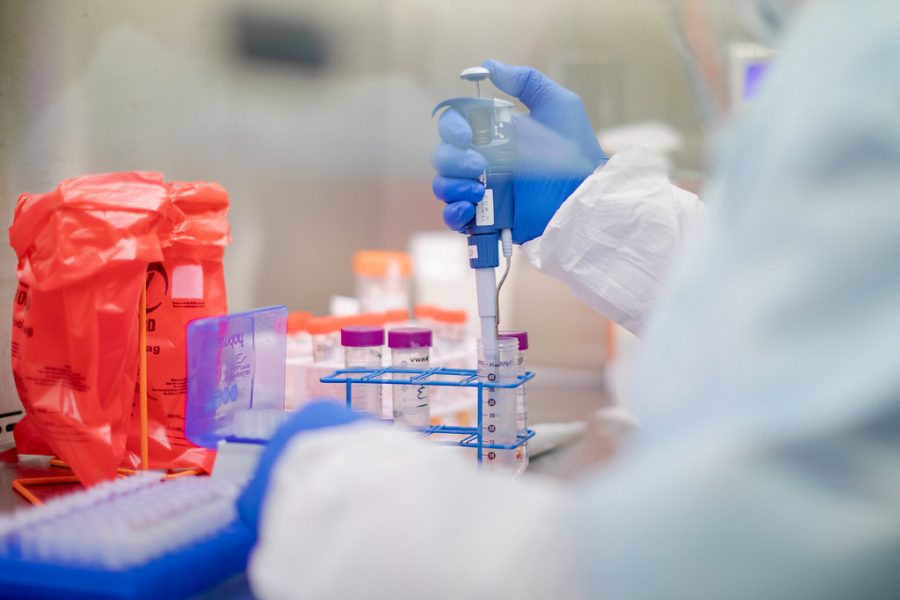COVID-19: myths and facts
A person places a syringe inside a test tube.
March 13, 2020
As COVID-19 spreads around the world, humanity must equip itself with the correct knowledge before allowing racism and false information to propagate. Oregon got its first case of COVID-19 on Saturday, February 29 at a Lake Oswego elementary school. As the number of Oregon cases rises to 32, buildings across the state close, and gatherings are canceled, panic rises. And this panic leads to misinformation—so much so that according to Business Insider, the World Health Organization has joined TikTok to get the correct information out. With so many misconceptions about the virus floating around, it’s time to take a couple of COVID-19 myths out with the trash.
Myth #1: Masks are necessary for all people, whether or not they have been infected.
According to John Hopkins University, masks should only be used by medical professionals and those who are sick and have underlying health conditions. The media is creating mass panic over the coronavirus, causing shortages in many supplies including masks, and this is problematic for people who need them. If you are a reasonably healthy person who is not a medical professional and don’t have COVID-19, avoid hoarding masks. Leave them for those who need them—which includes people showing systems, caretakers, and health workers. Note, however, that this guidance differs from country to country: In China, for example, where over 80,000 cases have been confirmed, it is recommended to wear a mask. Check with the CDC and other credible sources before stockpiling.
Myth #2: Heat kills the coronavirus.
This one isn’t exactly a myth, but it isn’t to be taken as fact, either. President Trump has claimed that the coronavirus will dissipate in the spring due to higher temperatures, but not enough is yet known about the virus to say this for sure. What can be said with certainty is that the coronavirus is not identical to the flu—so don’t assume what works with the flu will work with the coronavirus.
Myth #3: Younger people are immune to the coronavirus.
A common student reply to “Wash your hands!” is “I won’t get infected. It doesn’t matter.” But this isn’t the case. While COVID-19 has a mortality rate of under 1% up to 49 years of age and has not killed anyone under the age of 9 as yet, people in this age group can still catch the coronavirus and spread it to others. For those who have weakened immune systems or underlying medical conditions or are in regular contact with those who do, high schoolers with poor hygiene are a concern.
Myth #4: There is a miracle cure to the virus.
So-called miracle cures to the virus are being “unearthed” at an alarming rate. These cures include everything from staying hydrated and getting enough vitamin C to using steroids and drinking bleach. None are effective enough to make a substantial difference, and some are dangerous and should not be attempted. Instead, people should practice social distancing, wash their hands often with soap and water for a minimum of twenty seconds, and disinfect hard surfaces often.
Myth #5: Everyone who gets the virus will die from it.
Due to constant headlines about new COVID-19-related deaths, it’s easy to believe that the virus is a death sentence. But this is not the case. The overall mortality rate for the virus is 3%-4%, with those with underlying health issues and those of old age being affected the most. And according to The Hill, nearly 70,000 people have recovered from the illness.
Above all, remain calm. Offer support to those who need it, stay healthy and hygienic, and don’t take everything as fact until it’s been confirmed by multiple credible sources.
Government website: www.coronavirus.gov






![Social Media has contributed to the rise of the incel movement [Photo via Wikimedia Commons under Creative Commons license].](https://beavertonhummer.com/wp-content/uploads/2025/02/Man_on_a_smartphone_Unsplash-300x200.jpg)
![District changes have led to restrictions on AP classes for underclassmen [Graphic made with Canva].](https://beavertonhummer.com/wp-content/uploads/2024/06/Comic-Bonanza-300x300.png)
beavertonhigh • Mar 16, 2020 at 4:39 pm
Reblogged this on Beaver Tales and commented:
Via BeavertonHummer.com
LEARNING TRANSFORMS US.
#ExperienceBHS #ourBHSstory